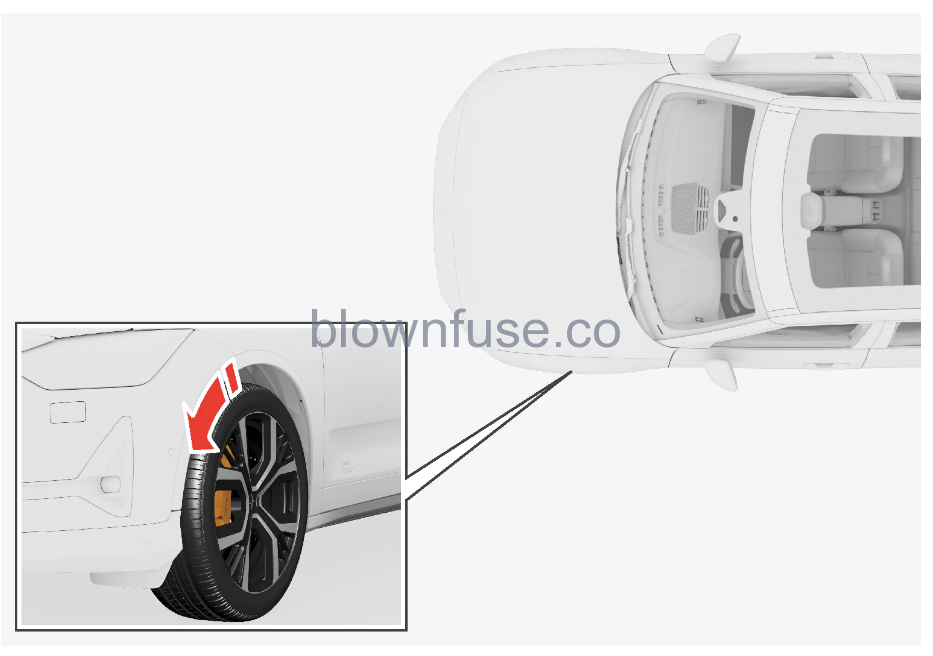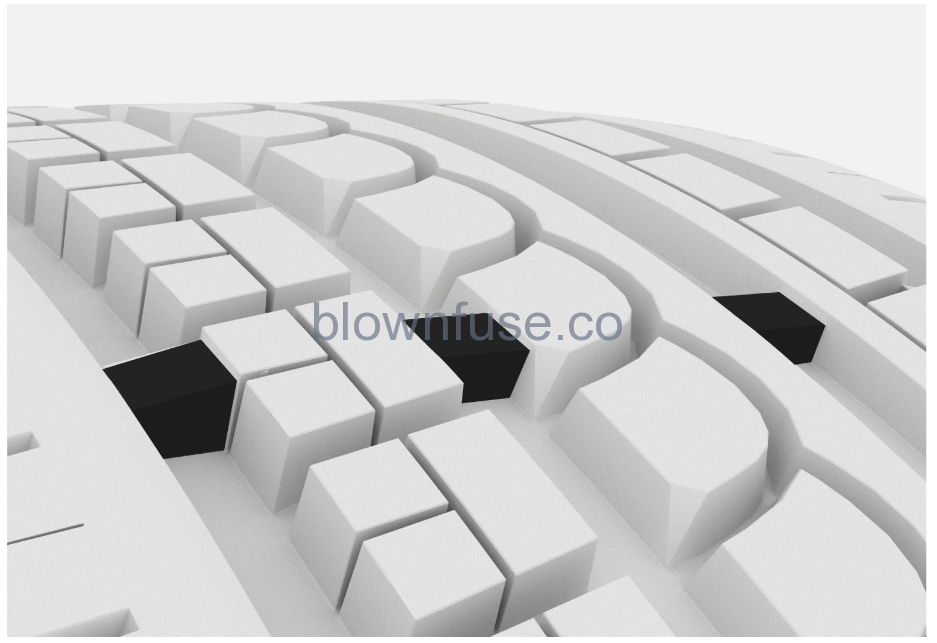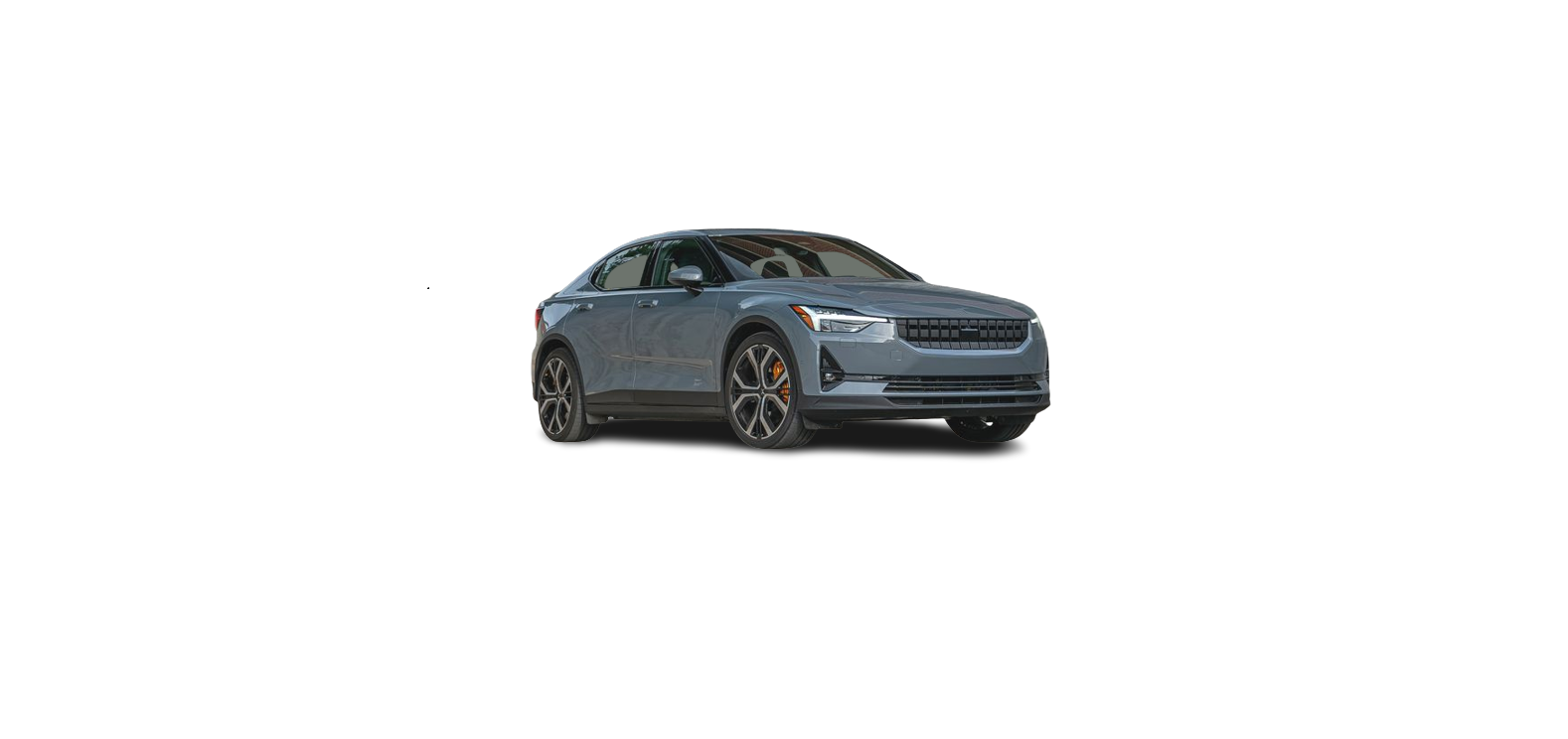2021 Polestar 2 Tires
Tire direction of rotation

The arrow shows the tire’s direction of rotation.
- The tire should maintain the same direction of rotation throughout its service life.
- Incorrectly mounted tires impair the vehicle’s braking properties and ability to force aside rain, snow and slush.
Use tires of the same type, dimensions and make (manufacturer) on each axle. Note that the front wheels have different dimensions than the rear wheels.
Tire sidewall designations

Federal law mandates that tire manufacturers place standardized information on the sidewall of all tires (see the illustration).
The vehicle has been certified with certain combinations of wheels and tires.
The following information is listed on the tire sidewall:
The tire designation:
Please be aware that the following tire designation is an example only and that this particular tire may not be available on your vehicle.
| 1. | 215: the width of the tire (in millimeters) from sidewall edge to sidewall edge. The larger the number, the wider the tire. |
| 2. | 65: The ratio of the tire’s height to its width in percent. |
| 3. | R: Radial tire (the designation RF and the |
| 4. | 15: The diameter of the wheel rim (in inches). |
| 5. | 95: The tire’s load index. In this example, a load index of 95 equals a maximum load of 1521 lbs (690 kg). |
| 6. | H: The tire’s speed rating, or the maximum speed at which the tire is designed to be driven for extended periods of time, carrying a permissible load for the vehicle, and with correct inflation pressure. For example, H indicates a speed rating of 210 km/h (130 mph). |
The tire’s load index and speed rating may not appear on the sidewall because they are not required by law.
| 7. | M+S or M/S = Mud and Snow, AT = All Terrain, AS = All Season |
| 8. | U.S. DOT Tire Identification Number (TIN): This begins with the letters “DOT” and indicates that the tire meets all federal standards. The next two numbers are the factory code where the tire was manufactured, the next two are the tire size code and the last four numbers represent the week and year the tire was made. For example, 0717 means that the tire was manufactured during week 7 of 2017. The numbers in between are marketing codes used at the manufacturer’s discretion. This information helps a tire manufacturer identify a tire for safety recall purposes. |
| 9. | Tire Ply Composition and Material Used: Indicates the number of plies indicates or the number of layers of rubber-coated fabric in the tire tread and sidewall. Tire manufacturers also must indicate the ply materials in the tire and the sidewall, which include steel, nylon, polyester, and others. |
| 10. | Maximum Load: Indicates the maximum load in pounds and kilograms that can be carried by the tire. Refer to the vehicle’s tire information placard located on the B-Pillar for the correct tire pressure for your vehicle. |
| 11. | Treadwear, Traction, and Temperature grades. |
| 12. | Maximum permissible inflation pressure: the greatest amount of air pressure that should ever be put in the tire. This limit is set by the tire manufacturer. |
Speed Symbol
A tire’s Speed Symbol (SS) indicates the maximum speed for which the tire has been certified and should be at least equivalent to the vehicle’s top speed.
Winter tires, with or without studs, are exceptions and may use a lower SS. When winter tires are installed, the vehicle may not be driven faster than the tires’ SS.
The vehicle’s speed should always be determined by the posted speed limit and traffic and road conditions, not the tire’s SS.
The following table indicates the maximum permissible speed for each SS.
| M | 130 km/h (81 mph) |
| Q | 160 km/h (100 mph) |
| T | 190 km/h (118 mph) |
| H | 210 km/h (130 mph) |
| V | 240 km/h (149 mph) |
| W | 270 km/h (168 mph) |
| Y | 300 km/h (186 mph) |
- The wheel and tire sizes for your Polestar are specified to meet stringent stability and handling requirements. Unapproved wheel/tire size combinations can negatively affect your vehicle’s stability and handling.
- Any damage caused by installation of unapproved wheel/tire size combinations will not be covered by your new vehicle warranty. Polestar assumes no responsibility for fatalities, injuries or expenses that may result from such installations.
Tire terminology
The tire suppliers may have additional markings, notes or warnings such as standard load, radial tubeless, etc.
- Tire information placard: A placard showing the OE (Original Equipment) tire sizes, recommended inflation pressure, and the maximum weight the vehicle can carry.
- Tire Identification Number (TIN): A number on the sidewall of each tire providing information about the tire brand and manufacturing plant, tire size and date of manufacture.
- Inflation pressure: A measure of the amount of air in a tire.
- Standard load: A class of P-metric or Metric tires designed to carry a maximum load at 35 psi [37 psi (2.5 bar) for Metric tires]. Increasing the inflation pressure beyond this pressure will not increase the tires load carrying capability.
- Extra load: A class of P-metric or Metric tires designed to carry a heavier maximum load at 41 psi [43 psi (2.9 bar) for Metric tires]. Increasing the inflation pressure beyond this pressure will not increase the tire’s load carrying capability.
- kPa: Kilopascal, a metric unit of air pressure.
- PSI: Pounds per square inch, a standard unit of air pressure.
- B-pillar: The structural member at the side of the vehicle behind the front door.
- Bead area of the tire: Area of the tire next to the rim.
- Sidewall of the tire: Area between the bead area and the tread.
- Tread area of the tire: Area of the perimeter of the tire that contacts the road when mounted on the vehicle.
- Rim: The metal support (wheel) for a tire or a tire and tube assembly upon which the tire beads are seated.
- Maximum load rating: a figure indicating the maximum load in pounds and kilograms that can be carried by the tire. This rating is established by the tire manufacturer.
- Maximum permissible inflation pressure: the greatest amount of air pressure that should ever be put in the tire. This limit is set by the tire manufacturer.
- Recommended tire inflation pressure: inflation pressure, established by Polestar, which is based on the type of tires that are mounted on a vehicle at the factory. This information can be found on the tire inflation placard(s) located on the driver’s side B-pillar and in the tire inflation table.
- Cold tires: The tires are considered to be cold when they have the same temperature as the surrounding (ambient) air. This temperature is normally reached after the vehicle has been parked for at least 3 hours.
Tread wear indicator

The tread wear indicator is a narrow elevated strip running across the tire’s longitudinal tread grooves. The letters TWI (Tread Wear Indicator) are visible on the side of the tire. When approximately 1.6 mm (1/16 inch) is left on the tread, the tread will be at the same height as the tread wear indicator. Replace the tire as soon as possible. Tires with low tread offer very poor traction in rain or snow.
Uniform Tire Quality Grading
Quality grades can be found, where applicable, on the tire sidewall between the tread shoulder and maximum section width. For example:
Treadwear 200 Traction AA Temperature A
TREADWEAR
The treadwear grade is a comparative rating based on the wear rate of the tire when tested under controlled conditions on a specified government test course. For example, a tire graded 150 would wear one and one half (1 ½) times as well on the government course as a tire graded 100. The relative performance of tires depends upon the actual conditions of their use, however, and many depart significantly from the norm due to variation in driving habits, maintenance practices and differences in road characteristics and climate.
TRACTION
The traction grades, from highest to lowest, are AA, A, B, and C, as measured under controlled conditions on specified government test surfaces of asphalt and concrete. A tire marked C may have poor traction performance.
The traction grade assigned to this tire is based on braking (straight-ahead) traction tests and is not a measure of cornering (turning) traction.
TEMPERATURE
The temperature grades are A (the highest), B, and C, representing the tire’s resistance to the generation of heat and its ability to dissipate heat when tested under controlled conditions on a specified indoor laboratory test wheel. Sustained high temperature can cause the material of the tire to degenerate and reduce tire life, and excessive temperature can lead to sudden tire failure. The grade C corresponds to a minimum level of performance that all passenger vehicle tires must meet under the Federal Motor Safety Standard No. 109. Grades B and A represent higher levels of performance on the laboratory test wheel than the minimum required by law.


